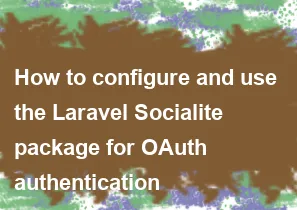How to configure and use the Laravel Socialite package for OAuth authentication

Laravel Socialite is a package that simplifies the process of OAuth authentication with various social media platforms such as Facebook, Twitter, Google, and more. Below, I'll provide you with a step-by-step guide on how to configure and use Laravel Socialite for OAuth authentication.
Step 1: Install Socialite Package
You can install Laravel Socialite using Composer. Open your terminal and run the following command:
| composer require laravel/socialite |
Step 2: Configure OAuth Credentials
Once the package is installed, you need to configure your OAuth credentials for each social platform you want to use. Add the following configuration to your config/services.php file:
'github' => [ 'client_id' => env('GITHUB_CLIENT_ID'), 'client_secret' => env('GITHUB_CLIENT_SECRET'), 'redirect' => env('GITHUB_REDIRECT_URI'), ], |
Make sure to replace github with the appropriate provider name (e.g., facebook, twitter, google) and set the corresponding client_id, client_secret, and redirect values. You can obtain these values by creating an application on the respective platform's developer console.
Step 3: Update .env file
Add the OAuth credentials to your .env file:
GITHUB_CLIENT_ID=your-github-client-id GITHUB_CLIENT_SECRET=your-github-client-secret GITHUB_REDIRECT_URI=http://your-app-url/callback |
Step 4: Create Routes and Controller
Create routes in your routes/web.php file to handle the OAuth authentication flow:
use App\Http\Controllers\Auth\SocialiteController; Route::get('auth/{provider}', [SocialiteController::class, 'redirectToProvider']); Route::get('auth/{provider}/callback', [SocialiteController::class, 'handleProviderCallback']); |
Now, create a controller using the Artisan command:
| php artisan make:controller Auth/SocialiteController |
Step 5: Implement Controller Methods
Update your SocialiteController.php file to include the following methods:
namespace App\Http\Controllers\Auth; use Laravel\Socialite\Facades\Socialite; use Illuminate\Http\Request; use App\Http\Controllers\Controller; use App\Models\User; class SocialiteController extends Controller { public function redirectToProvider($provider) { return Socialite::driver($provider)->redirect(); } public function handleProviderCallback($provider) { $socialiteUser = Socialite::driver($provider)->user(); $user = User::firstOrCreate( ['email' => $socialiteUser->getEmail()], [ 'name' => $socialiteUser->getName(), 'password' => bcrypt(str_random(16)), ] ); auth()->login($user); return redirect('/home'); } } |
Step 6: Update User Model
Make sure your User model includes the Socialite trait. Open your User.php file and add the following:
use Laravel\Socialite\Two\User as SocialiteUser; class User extends Authenticatable { use Notifiable, Socialite; // ... } |
Step 7: Usage
You can now use the /auth/{provider} route to initiate the OAuth authentication flow. For example, to authenticate with GitHub, you would visit /auth/github.
After the user authorizes the application, they will be redirected to the /auth/{provider}/callback route, where their information is processed, and they are logged in.
Remember to customize the code according to your application's specific requirements and follow the documentation for each social platform for additional configuration options and features.
=== Happy Coding :)
-
Popular Post
- How to optimize for Google's About This Result feature for local businesses
- How to implement multi-language support in an Express.js application
- How to handle and optimize for changes in mobile search behavior
- How to handle CORS in a Node.js application
- How to use Vue.js with a UI framework (e.g., Vuetify, Element UI)
- How to configure Laravel Telescope for monitoring and profiling API requests
- How to create a command-line tool using the Commander.js library in Node.js
- How to implement code splitting in a React.js application
- How to use the AWS SDK for Node.js to interact with various AWS services
- How to use the Node.js Stream API for efficient data processing
- How to implement a cookie parser middleware in Node.js
- How to implement WebSockets for real-time communication in React
-
Latest Post
- How to implement a dynamic form with dynamic field styling based on user input in Next.js
- How to create a custom hook for handling user interactions with the browser's device motion in Next.js
- How to create a custom hook for handling user interactions with the browser's battery status in Next.js
- How to implement a dynamic form with dynamic field visibility based on user input in Next.js
- How to implement a dynamic form with real-time collaboration features in Next.js
- How to create a custom hook for handling user interactions with the browser's media devices in Next.js
- How to use the useSWRInfinite hook for paginating data with a custom loading indicator in Next.js
- How to create a custom hook for handling user interactions with the browser's network status in Next.js
- How to create a custom hook for handling user interactions with the browser's location in Next.js
- How to implement a dynamic form with multi-language support in Next.js
- How to create a custom hook for handling user interactions with the browser's ambient light sensor in Next.js
- How to use the useHover hook for creating interactive image zoom effects in Next.js